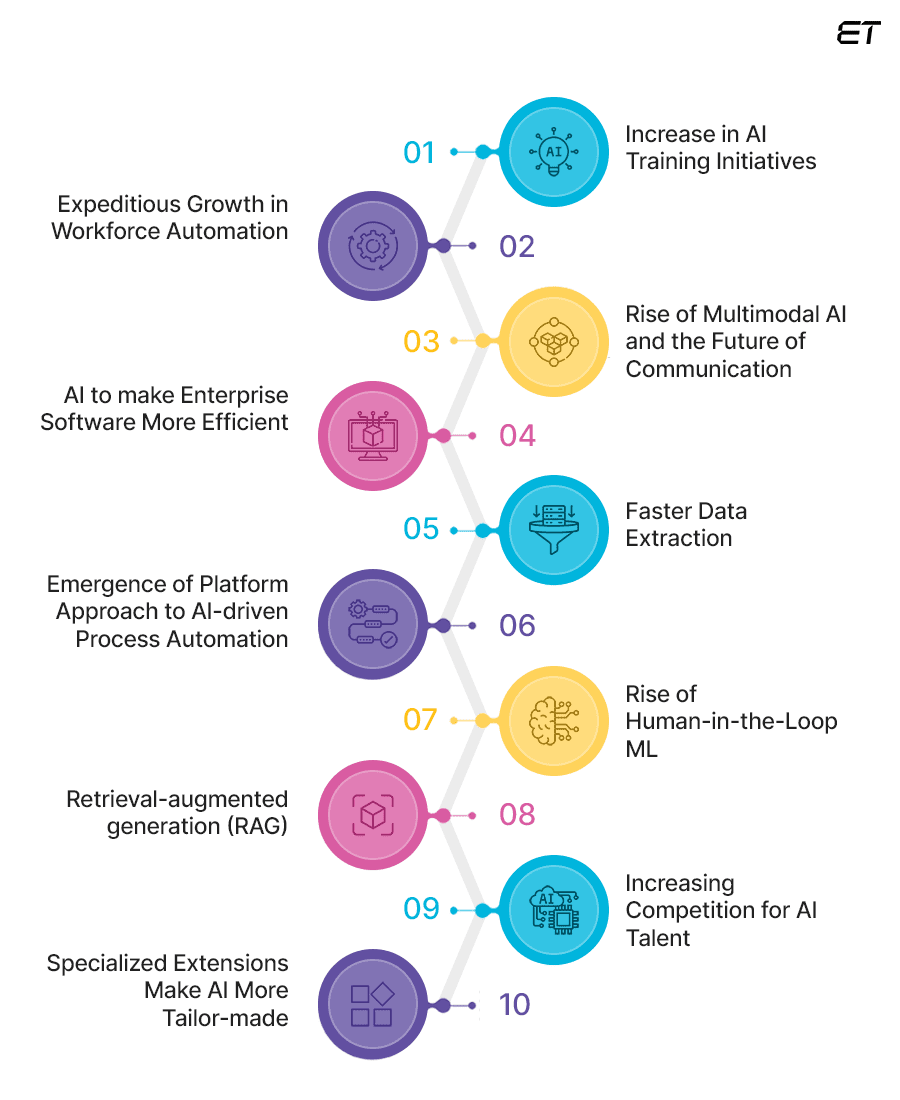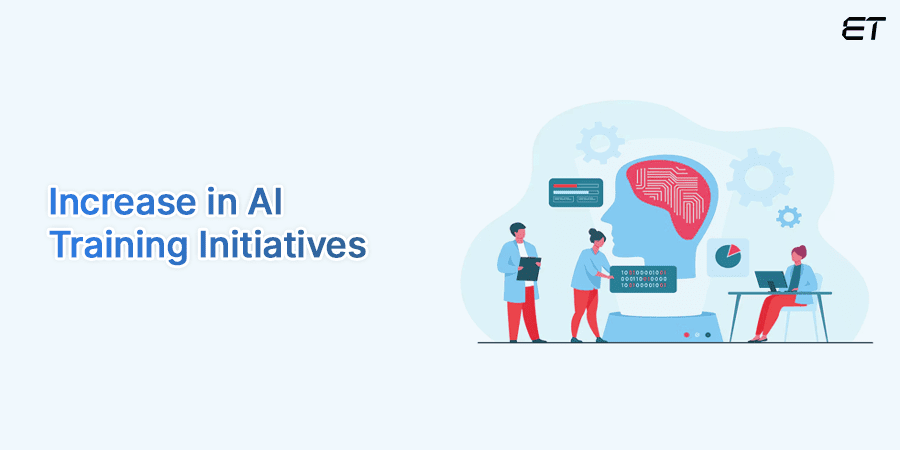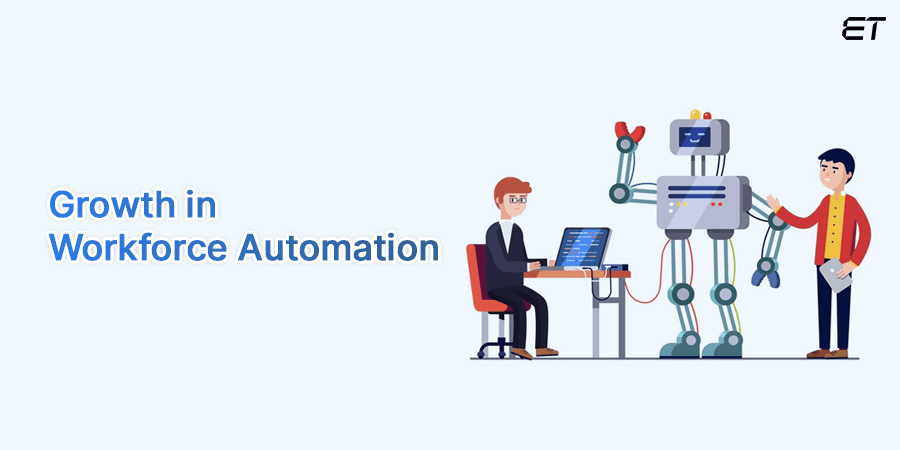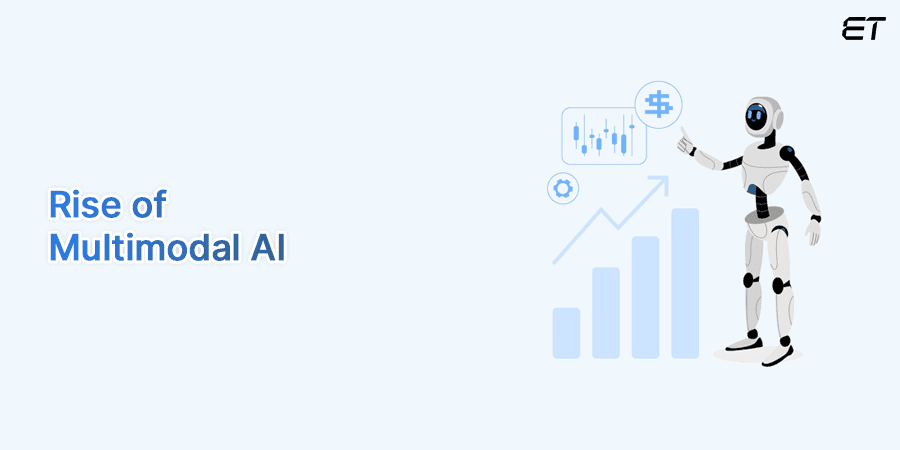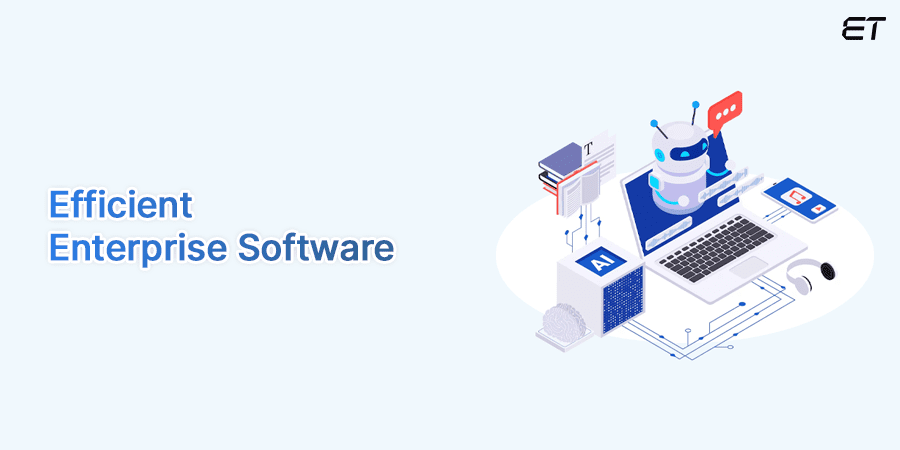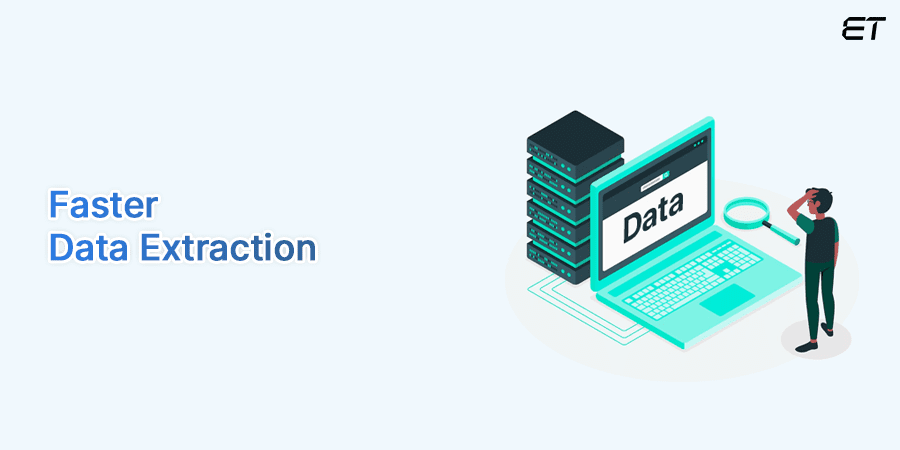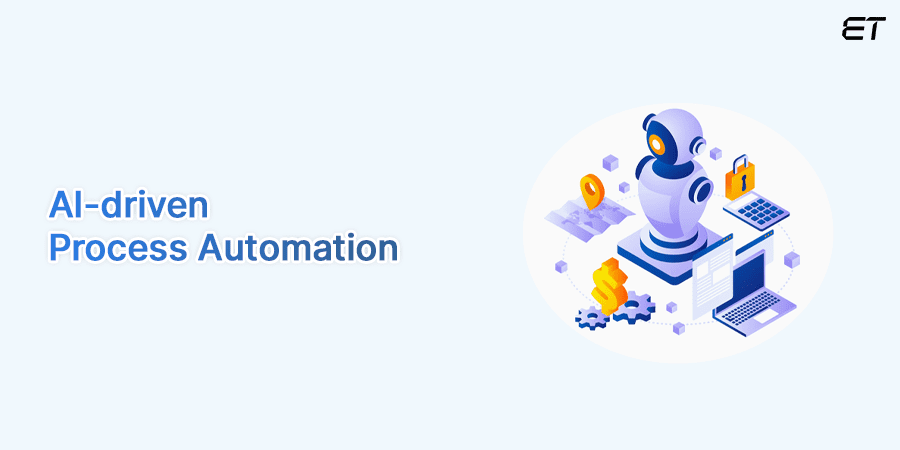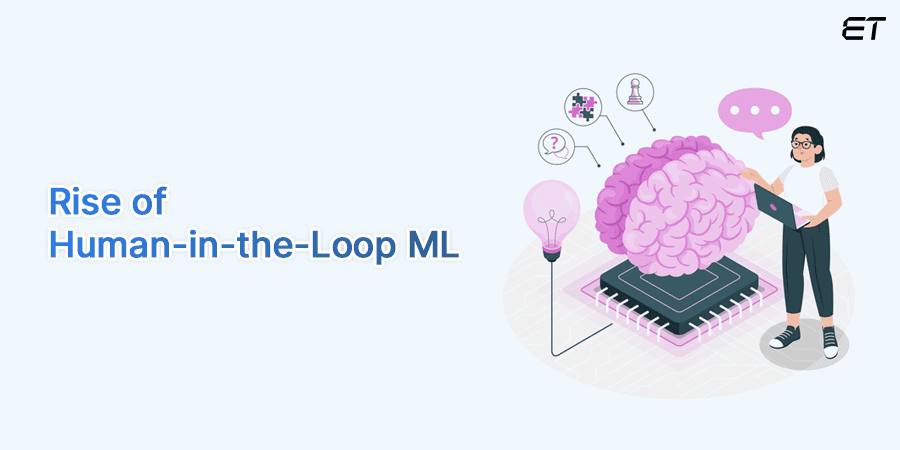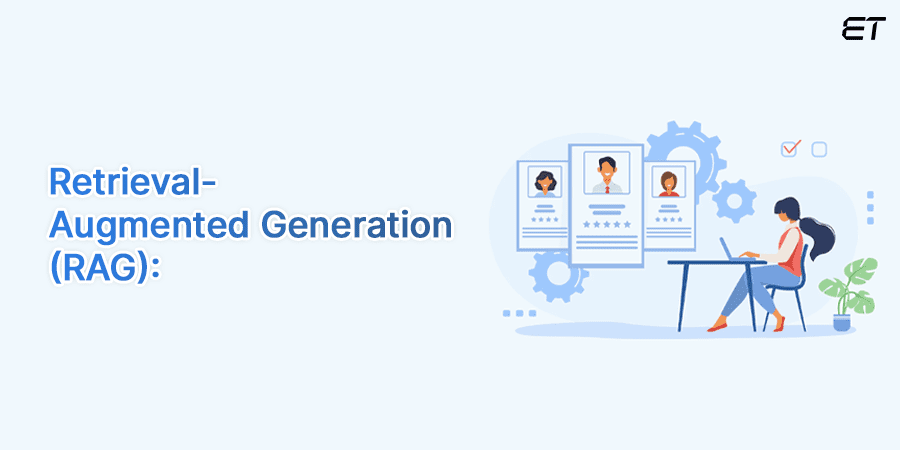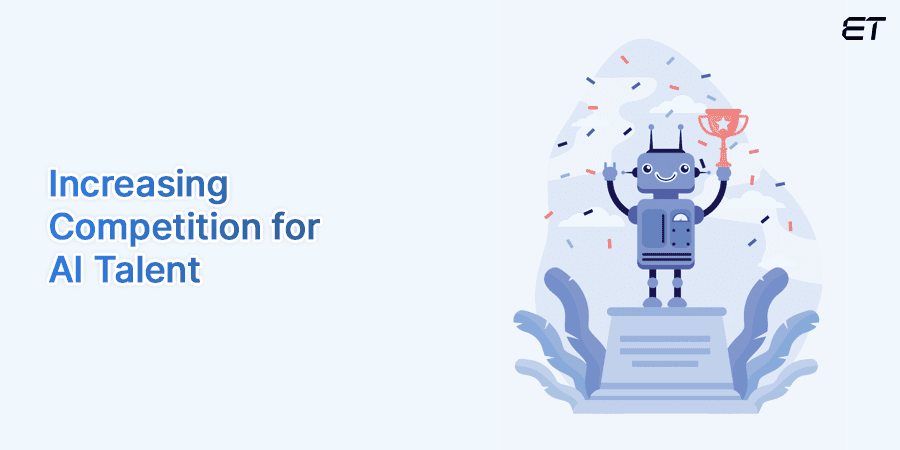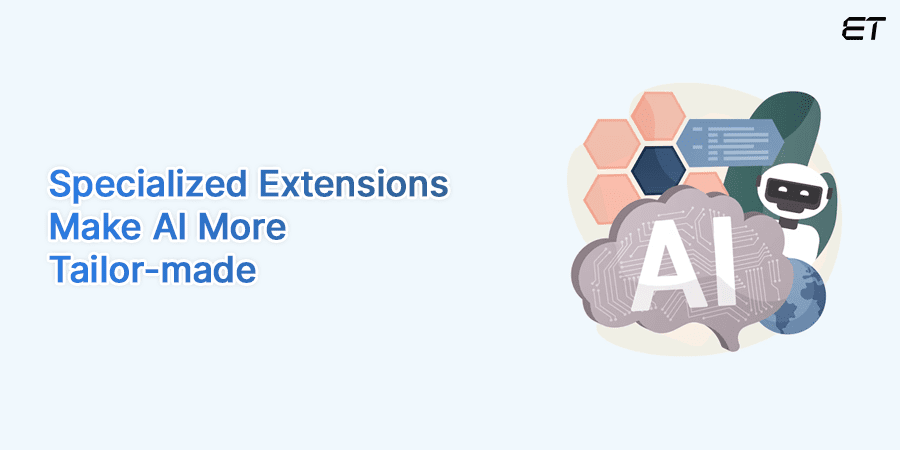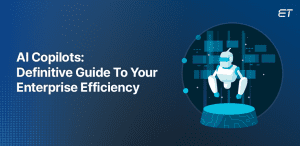Enterprise AI trends are revolutionizing every facet of business. From marketing to supply chain management, it catalyzes unparalleled levels of efficiency. Enterprises are embracing AI, with over 40% of Global 2000 organizations expected to allocate their core IT budgets to AI initiatives by 2025.
For navigation within the dynamic realms of the AI integration industry, it is crucial to remain abreast of emerging enterprise AI trends and the maturation of this technology. This article will explore the top 10 enterprise AI trends in 2024, providing you with the latest insight.
1. Increase in AI Training Initiatives: Enterprise AI Trends
A recent report by the McKinsey Global Institute estimated that by 2030, up to 800 million jobs could be affected by automation. To address this evolving landscape, an additional 375 million jobs will be transformed through AI. The Organizations are actively investing in AI training initiatives.
Furthermore, a 2023 survey conducted by Forbes Insights revealed that 72% of executives believe that AI reskilling and upskilling programs are critical for their organization’s success.
The survey also found that 62% of organizations have already implemented or plan to implement AI training programs for their workforce.
The Importance of Continuous Learning
The rise in AI training initiatives highlights the importance of continuous learning and development in today’s workplace.
By equipping their employees with the necessary AI skills, organizations can ensure they remain competitive and adaptable to technological advancements.
2. Expeditious Growth in Workforce Automation: Enterprise AI Trends
The global AI market is experiencing explosive growth, valued at $145.6 billion and projected to reach a staggering $302.84 billion by 2027. The compound annual growth rate (CAGR) is 26.7%.
This exponential rise underscores the growing importance of Artificial Intelligence in driving workforce automation.
Revolutionizing Workflows, One Industry at a Time
This AI boom is fundamentally transforming job roles across diverse industries. Repetitive and manual tasks are increasingly automated, prompting companies to adopt more efficient workflows.
For example, in manufacturing, robots are taking over assembly line tasks, while in customer service, chatbots are handling routine inquiries.
3. Rise of Multimodal AI and the Future of Communication: Enterprise AI Trends
Imagine a world where AI understands your text messages accompanying a selfie and analyzes them to grasp your genuine emotions.
This mind-bending scenario is becoming a reality with the emergence of Multimodal Large Language Models (MLLMs).
Take Google’s Gemini and OpenAI’s ChatGPT (GPT-4V) for example. Advanced models interpret vacation photos, create captivating captions, and analyze medical scans.
The rise of MLLMs is propelled by the booming computer vision market, outpacing NLP with a 36.6% CAGR.
Think of AI as gaining a new set of senses, allowing it to “see” and understand the world in a way that traditional language models simply can’t.
The implications are vast. Imagine a future where customer service chatbots can analyze your frustrated expression during a video call and adjust their tone accordingly.
MLLMs herald a new era of human-AI interaction, transcending traditional chatbots for more intuitive engagement. They facilitate the seamless integration of technology into our natural interactions.
4. AI to make Enterprise Software More Efficient: Enterprise AI Trends
Prepare for a workplace revolution; imagine your enterprise software, the programs you rely on to get things done, becoming infused with artificial intelligence. That’s the future, as Deloitte
predicted. Generative AI will become the secret sauce behind nearly all enterprise software offerings by 2024.
This isn’t about ripping out and replacing everything you know. Think of it more like supercharging your existing tools. AI is being seamlessly embedded into familiar software, making it more powerful and intelligent without requiring complex integrations or learning entirely new programs.
Here’s a glimpse of what this future holds:
- Microsoft 365 Copilot: Imagine it as a superpowered Word or Excel fueled by large language models. Copilot will analyze your data, generate reports, and even help you write emails faster.
- Google Duet AI: Real-time insights and predictive text in your Google Docs? Duet AI will streamline teamwork by anticipating your next move and offering helpful suggestions as you collaborate.
- Salesforce Einstein: AI will significantly boost Salesforce’s CRM platform. Einstein will take customer service, marketing automation, and data analysis to a whole new level.
- Atlassian’s AI Features: Managing projects just got easier. Atlassian’s AI will help automate repetitive tasks, optimize workflows, and empower you to make smarter decisions.
This is just the beginning. By embedding AI into enterprise software, businesses can unlock a new era of efficiency, productivity, and more competent decision-making abilities. So, buckle up and get ready for an AI-powered office revolution.
5. Faster Data Extraction: Enterprise AI Trends
Thanks to advancements in AI, particularly multimodal large language models (MLLMs), the days of tediously inputting data from piles of paperwork are long gone.
Created by JPMorgan, a new specialized AI (DocLLM) has entered the market. It is designed to handle complex documents like PDFs easily.
Here’s what makes DocLLM a game-changer:
- Lightweight Champion: unlike other complex AI tools, DocLLM is a super-fast document reader. It can analyze document setup, like the size and location of text boxes. It can read a page like you can, understanding the placement of all the different sections.
- Formidable Form Reader: DocLLM outshines even the toughest competitors when it comes to form-based documents. It has registered a growth of 15% in accuracy.
- Textual Twists: DocLLm can enhance the readability of the language in business documents. It fills in missing bits of text and improves the presentation of the document.
DocLLM paves the way for a future where working with documents becomes much more accessible.
6. Emergence of Platform Approach to AI-driven Process Automation: Enterprise AI Trends
In the past, companies were using all the different tools for automation, which caused problems because they didn’t work well together. The results were unstable and inefficient.
Here is some good news! Platform-based AI automation is here to help. With a more organized approach and help from platforms like the Microsoft Power platform, the entire process is streamlined.
Let us try to understand this concept by taking the example of a bridge.
Here’s why it’s a game-changer:
- Goodbye, fragmentation: You can create a smooth and connected workflow by bringing all the different automation tools together. It signifies a bridge that has been well-planned and constructed for seamless operation
- Scalability for the win: with your growing need for automation, this platform can quickly adapt and expand. It acts as a bridge that can handle increasing traffic without needing a complete modification to its structure.
- Employee and Customer Journey Champions: These platforms can automate tasks for both employees and customers, making everyone’s experience smoother.
Using this platform makes AI automation easier to manage and use. It works efficiently and can grow as your company’s requirements change.
7. Rise of Human-in-the-Loop ML: Enterprise AI Trends
Are you worried about AI replacing humans? This AI isn’t just powerful; it’s accurate and reliable too. Human-in-the-Loop Machine Learning (HITL) focuses on the powerful collaboration of humans and AI.
Here’s how it works:
- Teaming Up for Success: HITL combines human expertise and machine learning capabilities. Platform-based AI brings together different automation tools as ingredients to create a powerful and efficient system.
- Speed Up and Avoid Stumbles: With human guidance in the development of AI, costly mistakes can be prevented and accuracy is ensured. The entire machine-learning process is streamlined with human intervention.
- Humans Aren’t Going Anywhere: According to Wharton Professor Lynn Wu, AI is a tool to augment human capabilities and not replace them. Just like athletes still need their own skills, we humans will remain crucial in the AI equation.
- The Feedback Loop: AI learns and constantly improves its output based on human feedback. As the main ingredient for a successful AI, continuous feedback loop is required. Imagine the coach analyzing the athlete’s performance and then working with them to refine their skills.
Here’s a sneak peek into the future of HITL:
- Fine-tuning the Machine: Humans will play a vital role in setting up AI systems, providing training data, and ensuring the model is on the right track. Think of the coach designing a personalized training plan for the athlete.
- Real-World Teamwork: Humans and AI will combine their expertise to tackle complex scenarios. Humans will identify issues in real-time situations and double-check AI outputs to provide optimal results. Imagine the coach and athlete working side-by-side during a competition, each playing a crucial role in achieving victory.
HITL represents a decisive shift in AI development, a future where humans and intelligent machines work together to achieve incredible things, embracing human-machine collaboration
8. Retrieval-augmented generation (RAG): Enterprise AI Trends
Retrieval-augmented generation (RAG) is a technique that boosts the accuracy and reliability of large language models (LLMs) like DocLLM.
Imagine an AI assistant who understands your questions and provides solutions backed up by verifiable facts. That’s the power of Retrieval-Augmented Generation (RAG) – a technology poised to revolutionize user trust in AI.
Here’s why:
- Fact-Checking on Steroids: RAG systems go beyond basic AI by consulting external knowledge bases, like online encyclopedias or industry reports. This ensures answers are based on real-world data, boosting user confidence by a whopping 22%.
- Combating “AI Hallucination”: You have all seen AI chatbots that make up information. RAG tackles this issue by comparing AI responses with reliable sources. It’s like having a built-in fact-checker for your AI assistant, ensuring information accuracy.
- Company Knowledge at Your Fingertips: RAG can tap into a company’s internal databases. AI systems can personalize responses based on specific company knowledge, leading to more relevant and trustworthy user interactions.
In short, RAG bridges the trust gap between humans and AI. By ensuring verifiable information and improving company-specific expertise, RAG paves the way for a future where users can trust AI for accurate and reliable information.
9. Increasing Competition for AI Talent: Enterprise AI Trends
The race for AI talent is on, and it’s a sprint! Over the past three years, job postings related to AI have reported a growth of 74%. With demand skyrocketing, companies are pulling out all the stops to attract and retain these highly skilled workers. Here’s a glimpse of what’s happening around us.
- The Great Upskilling Scramble: Companies are investing heavily in training existing employees to bridge the AI skills gap. Imagine an army rapidly equipping its troops with new weapons and strategies!
- Competitive Recruitment on Steroids: Recruiting for AI talent is no longer business as usual. Companies are offering competitive salaries, attractive benefits packages, and cutting-edge work environments to lure the best minds.
- Staff Augmentation: Bringing in the Cavalry: Many companies are turning to staff augmentation, bringing in temporary AI specialists to fill specific needs. It’s like calling in reinforcements to bolster your forces during a critical battle.
The competition for AI talent shows no signs of slowing down. Companies that can develop and implement effective strategies for attracting and retaining these top performers will be well-positioned to succeed in the age of artificial intelligence.
10. Specialized Extensions Make AI More Tailor-made: Enterprise AI Trends
The future of AI is looking custom-fit! There’s a growing trend towards specialized AI extensions, and businesses are loving it. These extensions act like add-ons for your existing AI tools, allowing you to pick and choose the functionalities that perfectly match your needs.
Think of it like customizing your smartphone. You don’t need every single app out there; you just download the ones that make your life easier. That’s the idea behind specialized AI extensions.
Marketplaces like OpenAI’s GPT Store and Microsoft’s Plugin Marketplace are leading the charge. Here’s why this trend is taking off:
- One-size-fits-all: Generic AI solutions are becoming a thing of the past. Meanwhile, businesses are demanding tools that cater to their specific challenges and goals.
- The Power of Choice: With the wide range of available extensions, businesses can choose the functionalities that provide the most value for them. Imagine having a library of tools at your disposal, and you can pick the exact ones you need to complete your project.
- A Growing Market: The demand for specialized AI extensions is expected to reach a whopping $827 billion by 2030 [Insert projected market size and year], reflecting the growing need for customized AI solutions (source needed).
This shift towards specialized AI extensions empowers businesses to unlock the full potential of AI. With tailored AI tools according to the need, companies can achieve greater efficiency, and improve decision-making.
Primary challenges enterprises encounter in AI adoption
Companies are jumping headfirst into the world of AI. They are eager to harness the power of large language models and cutting-edge generative AI to revolutionize their industries. But the road to automation is not easy.
Here are some of the biggest challenges faced by the major players
- Data Dilemmas: Companies are worried about three things: firstly, protecting their confidential information, and secondly, training the AI with their specific knowledge and skills. Lastly, find enough data to make the AI work effectively.
- Customizing the colossus: These AI models are impressive. However, businesses are concerned about the ability to customize the AI to their specific needs.
- Keeping the reins on the data dashboard: the companies need to decide who gets access to their data chest and what amount is accessible. Keeping the information secure is the utmost priority of the company, and ensures its responsible use.
- Performance Puzzlers: These AI models are powerful, but can they be pushed even further? And how much does it all cost? Imagine getting a new tool but wondering if it can handle your most significant project or how much that fancy new toolbox is going to set you back.
- Security Shenanigans: Data breaches and privacy concerns are a big worry. Companies don’t want their confidential information falling into the wrong hands, just like you wouldn’t want your secret family recipes leaked online.
So, while AI adoption is hot, some hurdles remain to be cleared. However, with careful planning and innovation, companies can overcome these challenges and unlock AI’s true potential.
Final Thoughts: Enterprise AI Trends
In 2024, the Enterprise AI trend will witness dynamic expansion, strategic investments, and emphasis on practical implementation.
Amidst this evolution, highlighted trends provide guidance for leveraging AI to spur innovation, efficiency, and a competitive edge. Enterprises embracing these developments will result in heightened investments, integration into business software, and specialized solutions.
Frequently asked questions: Enterprise AI Trends
1. What are the other Enterprise AI trends in 2024?
The prominent Enterprise AI business trend in 2024 is the establishment and enforcement of ethical guidelines and standards. This encompasses transparency, fairness, data privacy, and bias mitigation to ensure equitable and beneficial AI utilization.
2. What is the impact of AI in the year 2024?
In 2024, AI will revolutionize industries and human-machine interactions. Making workflow automation easier and more profitable for businesses.
3. What will the enterprise AI trend be in 2025?
With the AI market poised for exponential growth from $244 billion in 2025 to $827 billion by 2030, its potential for human-centric generativity expands.
Excellence-driven professional with 15+ years of experience in increasing productivity, and revenue, while effectively managing products of all sizes. He has worked for international clients in the US, UK, and Singapore and local companies in various domains. With excellent attention to detail and a methodical approach to execution, he is an expert in bringing projects to a successful stage. He follows James Humes’s famous saying- “The art of communication is the language of leadership.”

